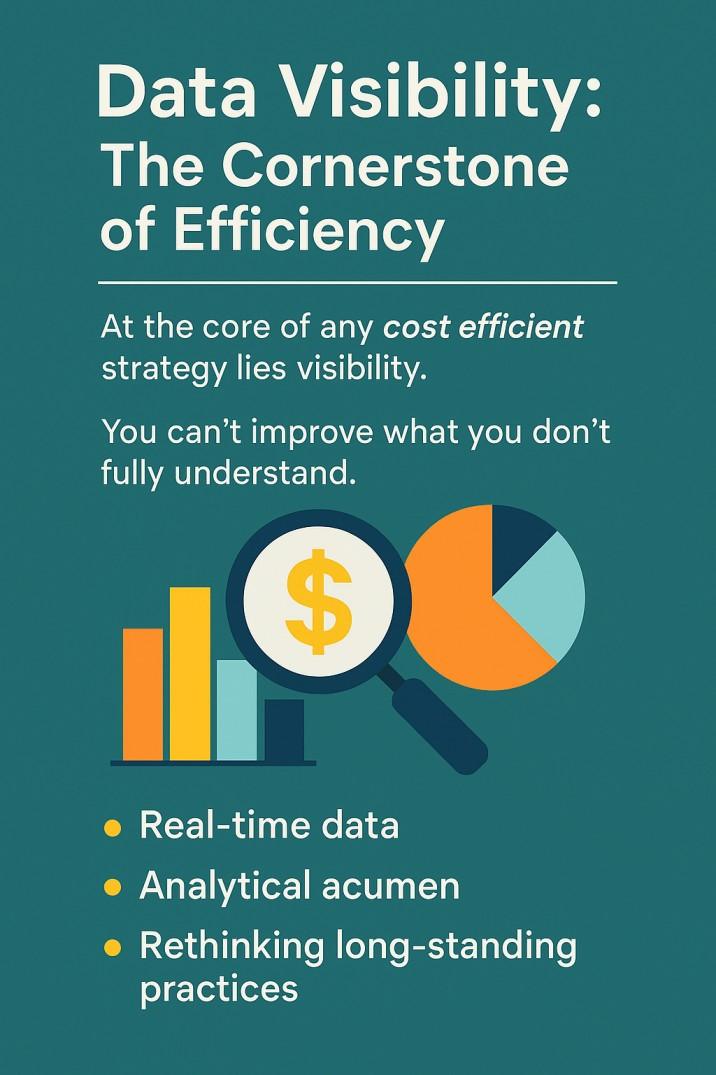Success no longer belongs to those who merely slash budgets or cut corners. It belongs to those who master cost efficient operations without compromising on quality.
To build a sustainable, profitable operation, businesses must shift away from reactive cost-cutting and move toward strategic cost efficiency. This means adopting smart systems, empowering people, and leveraging technology—all while maintaining, or even enhancing, product and service quality.
Redefining Cost Efficiency in the Modern Business Landscape
There’s a big difference between being cheap and being cost efficient. Cheap operations prioritize low costs at any cost—often sacrificing reliability, customer experience, and long-term brand trust. In contrast, cost efficient businesses are lean, but not fragile. They make deliberate, informed decisions that allow them to deliver strong outcomes with optimal resource use.
Being cost efficient is about knowing where your money matters—and where it doesn’t. It’s a mindset that considers total cost of ownership, lifetime customer value, and strategic trade-offs, not just immediate expense.
Data Visibility: The Cornerstone of Efficiency

One of the first steps toward becoming cost efficient is achieving full visibility into your operations. Without data, decision-makers are flying blind. Tools like real-time dashboards, KPI trackers, and ERP systems give companies the information they need to assess efficiency at every level—from supply chain throughput to marketing ROI.
By analyzing where time, money, and labor are being spent—and what’s being produced as a result—businesses can identify bottlenecks, eliminate redundancies, and streamline operations. This clarity forms the foundation of any sustainable cost efficient strategy.
Breaking Down Operational Silos for Unified Efficiency
Even with perfect data, a lack of collaboration can hinder cost efficient initiatives. Departments that don’t communicate create duplication, friction, and misaligned goals. Finance may focus on cutting costs, while marketing increases ad spend to drive growth, and production ramps up inventory—all without syncing strategies.
True cost efficient operations emerge when cross-functional alignment exists. Everyone—from procurement to product development—is on the same page, working toward shared efficiency goals. Integrated teams build streamlined workflows, reduce internal conflict, and collectively boost the bottom line.
Smart Manufacturing Without Quality Trade-Offs
Nowhere is the quality vs. cost dilemma more evident than in manufacturing. Historically, efforts to reduce expenses often led to lower-quality materials, fewer quality checks, or rushed production schedules—all of which ultimately compromised the final product. However, today’s landscape of cost effective manufacturing has radically evolved, allowing companies to save without sacrificing integrity.
A Shift from Cutting Corners to Cutting Waste
Modern manufacturing doesn’t look to cut corners—it aims to cut inefficiencies. This shift is largely driven by lean methodologies, which focus on streamlining operations by eliminating non-value-adding activities. Waste, whether it’s in the form of excess inventory, unnecessary motion, or production bottlenecks, is systematically targeted and removed.
By refining each step of the production process, manufacturers achieve a more cost effective system that improves throughput while maintaining rigorous quality standards.
Predictive Maintenance: Prevention Over Reaction
Downtime is one of the most expensive hidden costs in manufacturing. Traditional reactive maintenance strategies often result in unexpected equipment failure, production delays, and reduced product consistency. In contrast, predictive maintenance leverages sensors, real-time data, and analytics to anticipate problems before they occur.
This proactive approach keeps machines running at optimal performance and allows manufacturers to schedule maintenance during non-peak hours. The result is a more cost effective maintenance cycle that prevents disruptions while extending equipment lifespan—again, without any compromise on quality.
Precision Automation: Quality at Scale
Automation is often misunderstood as a mere cost-cutting tactic. In reality, precision automation enhances consistency, accuracy, and safety on the production floor. Robotics and smart machinery are programmed to perform tasks with minimal deviation, resulting in fewer defects and higher standards of workmanship.
Furthermore, automation allows companies to scale production without the quality control issues that arise from overworked or inconsistent labor. In this way, automation becomes a cost effective tool not just for saving money, but for sustaining excellence.
Strategic Investments for Long-Term Gains
One of the pillars of cost effective manufacturing is the willingness to make smart upfront investments that yield long-term returns. These might include energy-efficient equipment, advanced training programs for workers, or robust inventory management systems. Though the initial cost may be higher, the long-term benefits—lower utility bills, higher retention, faster turnover—pay off exponentially.
These investments create a resilient and adaptive manufacturing ecosystem that grows stronger over time, rather than degrading in pursuit of short-term margins.
IT and Tech: Modernizing for Efficiency
In IT, being cost efficient isn’t about cutting support staff or canceling software licenses blindly. Instead, it’s about rationalizing infrastructure. Cloud platforms offer scalability that eliminates the need for over-provisioned servers. Open-source software reduces licensing fees. Cybersecurity investments prevent far costlier data breaches.
A cost efficient IT operation is both robust and agile. It reduces total cost of ownership while providing the tools teams need to move quickly and securely. When digital operations are optimized, the entire organization becomes more resilient and scalable.
Reframing the Narrative Around Cost Cutting
Cost efficiency is often confused with austerity. This misunderstanding can create employee anxiety or organizational resistance. To successfully implement cost efficient changes, leadership must shift the narrative from cost reduction to value optimization.
When teams understand that the goal is smarter—not fewer—resources, they’re more likely to embrace change. Transparent communication, strategic planning, and clear evidence of improved outcomes can build trust and reduce resistance.
The Human-AI Balance in Operational Optimization
Automation has unlocked new possibilities for cost efficient operations. Repetitive tasks like data entry, invoicing, or customer support triage can be automated to save time and labor. However, efficiency doesn’t mean eliminating human input entirely.
Smart organizations balance automation with human intelligence. For instance, AI can handle common customer queries, but trained agents are essential for complex or emotionally sensitive issues. This hybrid approach ensures consistency, speed, and empathy—hallmarks of quality.
Cheap vs. Cost Efficient: Understanding the Difference
The phrase cost efficient is often thrown around, but it’s essential to draw a clear distinction: cheapness sacrifices value, while efficiency optimizes it. A company might choose the cheapest supplier to cut costs but end up with defective parts, delays, and unhappy customers. What seemed like a savings quickly becomes a liability.
In contrast, a cost efficient supplier delivers good quality at a competitive rate, offering long-term stability and reliability. Efficiency is an investment in sustained performance—never a shortcut.
Real-World Efficiency: From Code to Campaigns
Let’s apply this to software development. Hiring ten junior developers might seem cheaper than five senior ones. But the latter may write better code faster, with fewer bugs and less need for rewrites—making them more cost efficient in the long run.
In marketing, efficiency means focusing on customer acquisition cost (CAC), not just impressions or clicks. A cost efficient campaign may have a smaller budget but yield higher-quality leads because it’s better targeted and more engaging.
Sustainability and Cost Efficiency Go Hand-in-Hand
Environmental sustainability and cost efficiency are not opposing forces—they’re mutually reinforcing. Energy-saving practices, optimized shipping routes, reduced packaging, and circular economy models all lower costs while enhancing corporate responsibility.
Adopting cost efficient sustainability initiatives also improves public image, attracts environmentally conscious customers, and often qualifies the business for grants, tax breaks, or carbon credits.
Vendor Relationships and Contract Re-Evaluation
In the fast-paced business landscape, vendor relationships and long-term contracts can become dangerously outdated. What once seemed like a great deal may now be a hidden drain on resources. Many companies, especially those scaling rapidly or operating across multiple departments, continue paying for services they no longer use—or worse, services that have been surpassed by better, cheaper alternatives.
The Cost of Complacency
Legacy vendors and auto-renewed contracts often operate in the background with minimal oversight. While this hands-off approach may save administrative effort, it comes at a long-term cost. These agreements are frequently signed in a different business context—at a time when priorities, market prices, and internal needs were significantly different.
Failing to question these arrangements can stifle innovation and waste precious budget. When procurement becomes habitual rather than strategic, businesses miss opportunities for cost efficient improvements.
Why Contract Audits Matter
Conducting a comprehensive vendor audit isn’t just about cutting costs. It’s about understanding what each contract delivers, identifying redundancies, and spotting opportunities for performance optimization. A well-run audit examines:
- Current usage vs. contractual terms
- Benchmarks against industry pricing
- Alternative providers or technologies
- Bundled services that no longer align with company goals
When this process is approached strategically, it reveals a roadmap for transforming fixed vendor costs into flexible, value-generating investments.
Renegotiating Without Compromising Quality
A common fear when renegotiating or switching vendors is that quality will take a hit. But this is a false dilemma. Many providers offer the same—or even better—service at lower cost, especially as competition increases and technologies evolve. By leveraging market data and past vendor performance, businesses can confidently pursue more cost efficient options while maintaining service standards.
Negotiation isn’t just about driving down price—it’s about securing more favorable terms: better support, faster delivery, enhanced customization, and flexible scaling.
Building Smarter Vendor Partnerships
Once outdated contracts are addressed, businesses should shift toward building smarter, more agile vendor relationships. This includes:
- Shorter contract cycles to maintain flexibility
- Performance-based clauses to ensure accountability
- Regular review checkpoints to reassess ongoing value
Establishing this rhythm ensures vendors stay aligned with your company’s evolving needs and budgets.
Cost Efficient Partnerships as a Strategic Lever
When vendor relationships are managed with intention, they become a strategic asset rather than a sunk cost. Regular re-evaluation and renegotiation foster an environment where partnerships are continuously optimized for both performance and cost efficiency. This not only improves your bottom line but also positions your business to pivot quickly when new opportunities arise.
Digital Transformation as a Catalyst for Efficiency
Digital transformation is one of the fastest routes to becoming more cost efficient. Cloud computing reduces capital expenditures. Project management platforms streamline workflows. Remote collaboration tools reduce the need for office space and travel.
These changes not only lower costs but also future-proof the organization. A digitally agile company can pivot quickly, scale efficiently, and respond to market shifts without massive overhead.
Leadership and Culture: Champions of Efficiency

Leadership sets the tone for everything. A culture of cost efficient thinking starts at the top. When executives prioritize smart investment over reckless expansion and reward teams for innovation and optimization, the message trickles down.
Teams are more likely to contribute to cost efficiency when they feel supported, trusted, and empowered. Leaders should champion lean processes, celebrate efficient wins, and maintain transparency about performance metrics.
Upskilling: The Hidden Efficiency Driver
Many companies cut training budgets to save money, but this often backfires. Well-trained employees make fewer mistakes, produce better work, and adapt faster to change. Investing in skill development leads to a more autonomous and cost efficient workforce.
Cross-training also adds flexibility. When staff can shift roles as needed, the company can operate smoothly without needing to hire extra personnel for short-term needs.
The Road Ahead
There is no final destination for operational efficiency. Markets shift, technologies evolve, and customer expectations rise. To remain cost efficient, businesses must continuously evaluate and refine their systems, tools, and workflows.
This journey requires commitment to learning, adaptation, and strategic investment. The companies that master cost efficient operations are not just survivors—they are market leaders, setting standards for quality, agility, and profitability.
Andrea Balint is a writer and researcher focused on human behavior, workplace psychology, and personal growth. Through her work at CareersMomentum, she explores how mindset, leadership, and emotional intelligence shape modern careers. With a background in communication and HR development, she transforms complex ideas into practical insights that help readers build clarity, confidence, and professional purpose.
